Pieter Coecke van Aelst
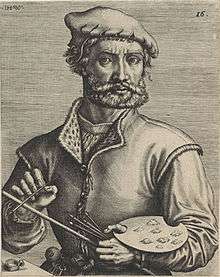
Pieter Coecke van Aelst or Pieter Coecke van Aelst the Elder (Aalst, 14 August 1502 – Brussels, 6 December 1550) was a Flemish painter, sculptor, architect, author and designer of woodcuts, stained glass and tapestries.[1] His principal subjects were Christian religious themes. He worked in Antwerp and Brussels and was appointed court painter to Charles V, Holy Roman Emperor.
Coecke van Aelst was a polyglot. He published translations of Ancient Roman and modern Italian architectural treatises into Flemish (Dutch), French and German. These publications played a crucial role in spreading Renaissance ideas to the Low Countries. They contributed to the transition in Northern Europe from the late Gothic style then prevalent towards a modern 'antique-oriented' architecture.
Life
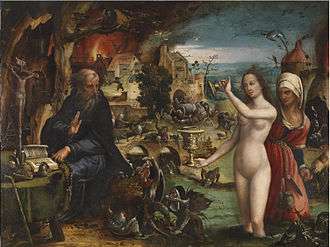
Pieter Coecke van Aelst was the son of the Deputy Mayor of Aalst. The early Flemish biographer Karel van Mander wrote in his Schilder-boeck published in 1604 that Coecke van Aelst studied under Bernard van Orley, a leading Renaissance painter based in Brussels. There are no documents that prove this apprenticeship but there are strong stylistic similarities between the styles of the two artists.[2]
According to Karel van Mander Pieter Coecke van Aelst later studied in Italy where in Rome he made drawings of sculpture and architecture. Although there is no firm evidence that Coecke van Aelst travelled to Italy, stylistic evidence supports the notion that he travelled to Italy. The Italian influence could, however, also be attributed to the fact that Raphael’s tapestry cartoons were available in Brussels, where they were used for the manufacture of tapestries around 1516. But Coecke van Aelst clearly also knew Raphael’s Triumph of Galatea fresco, which he could only have seen in Italy.[3]
Pieter Coecke van Aelst married twice. He married his first wife Anna van Dornicke in 1525 shortly after his move to Antwerp. Anna was the daughter of the Antwerp painter Jan Mertens van Dornicke, one of the most successful painters working in Antwerp.[4] His father in law may have been his teacher and Coecke van Aelst took over his father-in-law's workshop after the latter's death in 1527.[5] There were two children from this first marriage, Michiel and Pieter II. The latter was a painter.[2] After the death of his first wife before 1529, Coecke van Aelst had an affair with Anthonette van der Sandt (also known as Antonia van der Sant), whom he never married but with whom he had a daughter, Antonette, and at least one son, Pauwel who also became a painter.[4][6]

Coecke van Aelst is recorded joining the local Guild of Saint Luke of Antwerp in 1527. In 1533, he travelled to Constantinople where he stayed for one year in an attempt to persuade the Turkish sultan to give him tapestry commissions.[7] This mission failed to generate any commissions from the sultan. Coecke made many drawings during his stay in Turkey including of the buildings, people and the indigenous flora. He seems to have retained from this trip an abiding interest in the accurate rendering of nature that gave his tapestries an added dimension.[8] The drawings which Coecke van Aelst made during his stay in Turkey were posthumously published by his widow under the title Ces moeurs et fachons de faire de Turcz avecq les regions y appertenantes ont este au vif contrefaictez (Antwerp,1553).[9]
Upon his return to Antwerp in 1534, Coecke van Aelst produced designs for a large-scale figure, called 'Druon Antigoon' or the 'Giant of Antwerp' of which the head in papier-maché possibly still survives (Museum aan de Stroom, Antwerp).[2] The giant made its premiere many years later in 1549 at the occasion of the Joyous entry into Antwerp of Prince Philip (later Philip II). The giant became a regular fixture in public processions in Antwerp until the 20th century.[10] In the year 1537 Coecke van Aelst was elected dean of the Antwerp Guild of Saint Luke. He also received a stipend from the Antwerp city government.[6] Around this time Coecke van Aelst received major commissions for the design of stained-glass windows including for the Antwerp Cathedral. In the 1530s Coecke van Aelst's friend, the important painter Joos van Cleve died.[4]
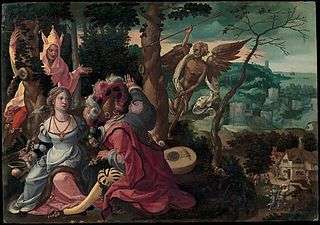
Around 1538-1539 Coecke van Aelst married for the second time. His second wife Mayken Verhulst was originally from Mechelen and a painter of miniatures. The couple had three children, two daughters called Katelijne and Maria and a son named Pauwel (even though he had another son with this name).[1][2] The prominent painter Pieter Brueghel the Elder married Coecke van Aelst's daughter Maria (called 'Mayken'). Karel van Mander has asserted that Coecke van Aelst's second wife was the first teacher of her grandchildren, Pieter Brueghel the Younger and Jan Brueghel the Elder. Through his marriage with Mayken Verhulst, Pieter Coecke became a brother-in-law of the prominent printmaker and publisher Hubertus Goltzius who had married Mayken's sister Elisabeth.[11]
There is speculation that Coecke set up a second workshop in Brussels but there is no evidence for this.[4] Coecke van Aelst was appointed court painter to Charles V a few months before his death.[2] Coecke was in Brussels in 1550 where he died in December. As his two youngest children both died at the same time, it is conceivable that all three family members fell victim to a contagious epidemic.[4]
His students included leading painters such as Gillis van Coninxloo, Willem Key, Hans Vredeman de Vries, Michiel Coxcie, and possibly Pieter Brueghel the Elder.[12]
Work
General
Pieter Coecke van Aelst was a versatile artist and a master designer who devised projects across various media, from tapestry series, to panel paintings, sculptures, prints, stained glass, and goldsmith's work.[13] No signed and few reliably documented paintings by Coecke van Aelst have survived.[2]
Coecke operated a large workshop, which was organized in an efficient way. He acted as an entrepreneur who provided his assistants with his original inventions and supervised the production process.[14] The style that he created was widely imitated.[2]
Last supper
His Last Supper was one of the most popular images of the sixteenth century. The version dated 1527 in the collection of the Duke and Duchess of Rutland, Belvoir Castle, Grantham, England is believed to be the original copy from which all the other ones were derived.[15] The composition was popularised through a print after it made by Hendrik Goltzius.

Coecke's painting of the subject was freely inspired by Leonardo da Vinci's Last Supper in Milan and Marcantonio Raimondi's engraving after Raphael's drawing of the same subject. The gestures of the apostles are based on a print by Albrecht Dürer of 1523. There exist about 45 versions in various formats of this composition, which were executed with the assistance of workshop assistants. A great number of the versions are dated, and 6 or 7 date to 1528. The Last Supper probably originated as a drawn model, which was then transferred to a panel by means of cartoons. The composition could be ordered in two formats: 50 x 60 cm and 60 x 80 cm.[14] The large format appears to have been the most popular. The original version of 1527 has an iconography closely related to the Reformation movement but in the copies this meaning is less pronounced.[15]
Small biblical scenes are depicted in the background of the composition, thus heightening the impact of the main theme. Through the window an Antwerp archway is visible and a scene depicting the Entry in Jerusalem of Jesus Christ, the principal event preceding the Last Supper according to Christian literature. Depictions of the Fall of Man are visible in the ornamented window. The medals on the wall represent the stories of David and Goliath and the Slaying of Cain. The scene with Cain and Abel is taken directly from a print by another popular Northern Renaissance artist, Jan Gossaert. The whole iconography accentuates the Christian occupation with original sin and mankind's salvation through Christ's sacrifice.[14]
St. Jerome in his study
Another popular and widely distributed work was the composition St. Jerome in his study of which Coecke van Aelst and his workshop produced multiple versions.

Saint Jerome is revered by Christians for his translation into Latin of the Bible, which he completed in a monastery in Palestine. In the version of the subject in the Walters Museum Coecke van Aelst suggests the Oriental setting by the view through the window which shows a landscape with camels. To the wall is affixed an admonitation, "Cogita Mori" (Think upon death), a vanitas motif that is reiterated by the skull. The saint's Bible is opened to an image of the Last Judgment, while the hourglass and candle are further reminders of the passage of time and the imminence of death.[16]
Another version of this subject was sold at Christie's (28 January 2015, New York, lot 104) and reprises similar iconographic elements which stress Christian beliefs regarding the transience of human life and the importance of the sacrifice of Christ for people to find salvation at the time of the so-called Last Judgement.[17]
Tapestry designs
Pieter Coecke van Aelst was renowned for his tapestry designs which were executed by the Brussels tapestry workshops.[18] These designs were typically small-scale drawings in black-and-white. His cartoon for the Martyrdom of St. Peter (Brussels Town Hall) is in grisaille with touches of green and red while the names of the other colors, such as gold or blue, are written in.[19]
.jpg)
The patrons for the tapestries included Emperor Charles V, Francis I of France, Henry VIII of England and Cosimo de' Medici.[13] He built a reputation as a tapestry designer with his popular series of the Story of Saint Paul, the Seven Deadly Sins, the Story of Abraham, the Story of Joshua, the Story of Vertumnus and Pomona, the Creation, the Conquest of Tunis, Poesia and Julius Caesar.[4]
Between 1545 and 1550 Coecke designed tapestries which show close attention to alternating architectural and landscape settings. Mary of Hungary, the governor of the Netherlands, appealed to Coecke to assist Jan Cornelisz. Vermeyen with the design of the Conquest of Tunis tapestry series. Designed around 1546, the Conquest of Tunis series recounts Charles V's successful recapture of Tunis from the Turks. Charles V's journey to Tunis occurred in 1535, some ten years before the design of these tapestries. Some earlier authors believed that Coecke himself had been a witness of the recapture of Tunis.

In Coecke's the Poesia series he depicts various tales from classical mythology inspired by Ovid's Metamorphoses. Only one set of the tapestries was ever woven after they were designed around 1547–1548. King Phillip II of Spain acquired the set in 1556. The Story of the Creation was designed around 1548 and acquired by Cosimo I de' Medici and Eleonora di Toledo.[20]
Graphic works
Coecke van Aelst's studio was well known for its graphic works and publications. Coecke van Aelst had during his visit to Turkey made drawings of local sights and scenes. The drawings were published posthumously in 1553 by his widow Mayken Verhulst under the title Ces moeurs et fachons de faire de Turcz avecq les regions y appertenantes ont este au vif contrefaictez (Antwerp,1553).
He was also the publisher and designer of a volume of prints entitled De seer wonderlijke…Triumphelijke Incompst van … Prince Philips commemorating the 1549 Joyous entry into Antwerp of Prince Philip (later Philip II). Coecke had himself designed some of the triumphal arches and stages that were reproduced in the volume.[21] It is believed that the appreciation for these prints at the Spanish court led to Coecke van Aelst's appointment as court painter to Charles V.[2]
Architectural publications
Pieter Coecke van Aelst was a gifted linguist and is noted for his translation of Vitruvius' De architectura into Flemish under the title Die inventie der colommen met haren coronementen ende maten. Wt Vitruuio ende andere diuersche auctoren optcorste vergadert, voor scilders, beeltsniders, steenhouders, &c. En allen die ghenuechte hebben in edificien der antiquen published first in 1539.[22] He, and after his death, his widow Mayken Verhulst, published the five books of Sebastiano Serlio's architectural treatise Architettura in Flemish, French and High German (the German translation was done by another translator). The first translation published was the fourth book of the Architettura published under the title Generale Reglen der architecturen op de vyve manieren van edificie in 1939.[2][21]

Coecke van Aelst’s translation of Vitruvius was hailed by the humanist Dominicus Lampsonius as the only Dutch-language book to discuss the building styles of other countries. In line with Italian translations of Vitruvius published earlier in the 16th century, Coecke's translation gave prominence to woodcut illustrations of the text and used columns to indicate the difference between three kinds of architectural representation: plan, elevation, and view. This was a clear break with the few treatises on architecture published earlier in the Low Countries which generally did not provide any visual exegesis.
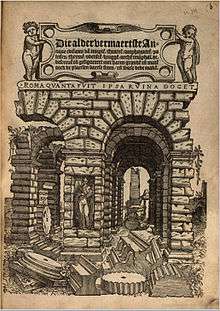
Coecke van Aelst’s 1539 Flemish translation of Serlio provided to the Low Countries a relatively affordable translation of one of the first illustrated architectural treatises in Europe. The original Italian edition had appeared in Venice only two years earlier. Coecke van Aelst’s Flemish (Dutch) edition in turn served as the basis for the first English translation of Serlio.[21] The translations of Serlio's works were in fact pirated editions since Serlio never authorised Coecke to translate and publish his works. In the Flemish translation of volume IV Serlio was only mentioned in the notice to the reader and in the colophon. The first translation in French by Coecke (also of Book IV) dated 1542 only mentioned Serlio in the colophon. In the first German translation dated 1543 Coecke mentioned Jacob Rechlinger from Augsburg as the translator but remained silent on Serlio's authorship. Serlio was clearly unhappy with these unauthorised translations and repeatedly threatened to sue Coecke who was, however, safe from prosecution as Coecke lived in a region under Spanish control while Serlio resided in France, an enemy of Spain.[23]
The translations of these important Roman and Italian architectural works played a crucial role in spreading Renaissance ideas to the Low Countries and hastening the transition from the late Gothic style prevalent in the area at the time towards a modern "antique-oriented" architecture in Northern Europe.[2] The translations were further instrumental in establishing a theoretical distinction between the acts of planning and executing a building. This led to the development of architecture as a new independent discipline distinguished from the craft of stonemason. In the Low Countries the relation between architecture and perspective also acquired theoretical backing in Coecke van Aelst’s translations. Coecke's translations of architectural publications had an important impact on the architect and graphic artist Hans Vredeman de Vries who is said to have assiduously copied their designs.[21]
In the interest of 'localisation', Coecke van Aelst’s translation made significant changes to Serlio’s original designs. For instance in one illustration he inserted 24 Latin block-letter patterns where Serlio had placed woodcuts of shields.[21]
Selected works
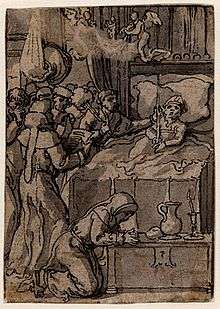
- Descent from the Cross, c. 1535, Oil on panel, 119 x 170 cm, Amstelkring Museum, Amsterdam
- The Adoration of the Magi, Oil on panel, Museo del Prado, Madrid
- Crucifixion, tapestry, Pinacoteca Comunale, Forlì
- Triptych, 1530s, Oil on panel, 105 x 68 cm (central), 105 x 28 cm (each wing), Private collection
- Triptych: Adoration of the Magi, Oil on panel, 89 x 57 cm (central), 89 x 25 cm (each wing), Private collection
- Triptych: Descent from the Cross, 1540–1550, Oil on panel, 262 x 172 cm (central), 274 x 84 cm (each wing), Museu Nacional de Arte Antiga, Lisbon
- Triptych of Saint James the Lesser and Saint Philip, Museu de Arte Sacra do Funchal
- The last Holy Communion, Kroměříž Archbishop's Palace picture gallery, Kroměříž [24]
References
- 1 2 Pieter Coecke van Aelst (I) at the Netherlands Institute for Art History (Dutch)
- 1 2 3 4 5 6 7 8 9 10 Jane Campbell Hutchison. "Coecke van Aelst Pieter, I." Grove Art Online. Oxford Art Online. Oxford University Press. Web. 8 Dec. 2014
- ↑ Pieter Coecke van Aelst at Sphinx Fine Arts
- 1 2 3 4 5 6 Getting to Know Pieter Coecke van Aelst at the Metropolitan Museum
- ↑ Pieter Coeck van Aelst, The Madonna with the Cushion at Gallery De Jonckheere
- 1 2 Frans Jozef Peter Van den Branden, Geschiedenis der Antwerpsche schilderschool, Antwerpen, 1883, p. 150-159 (Dutch)
- ↑ A. Wunder. "Western Travelers, Eastern Antiquities, and the Image of the Turk in Early Modern Europe" Journal of Early Modern History, 7 (2003).
- ↑ Roberta Smith, In Weft and Warp, Earth, Heaven and Hell ‘Grand Design’ Showcases Pieter Coecke Tapestries at the Met, 23 October 2014
- ↑ Online version of the Ces moeurs et fachons de faire de Turcz at the University of Ghent
- ↑ Göttler, Christine (2014), Druon Antigoon, der unzerstörbare Koloss: Städtischer Raum, antiquarische Kultur und Künstlerwissen im Antwerpen des 16. Jahrhunderts In: Nova, Alessandro; Hanke, Stephanie (eds.) Skulptur und Platz. Raumbesetzung, Raumüberwindung, Interaktion. I Mandorli: Vol. 20 (pp. 141-172). Berlin, München: Deutscher Kunstverlag (German)
- ↑ W. Le Loup. "Goltzius, Hubertus." Grove Art Online. Oxford Art Online. Oxford University Press. Web. 8 February 2016
- ↑ Van Mander stated that Bruegel was Coecke’s apprentice, an allegation which is no longer generally accepted in view of their substantial stylistic differences, see: Max J. Friedländer, 'Pieter Bruegel', comments and notes by Henri Pauwels, translated by Heinz Norden, A.W. Sijthoff, Leyden, 1978, p. 13
- 1 2 Grand Design, Pieter Coecke van Aelst and Renaissance Tapestry at the Metropolitan Museum of Art
- 1 2 3 Pieter Coecke van Aelst, The Last Supper, at Christie's
- 1 2 Sarah Mallory, Curatorial Conversations: Maryan Ainsworth on Coecke's Panel Paintings Posted 23 December 2014 on the Metropolitan Museum of Art
- ↑ St. Jerome in his study at the Walters Museum
- ↑ Pieter Coecke van Aelst I, Saint Jerome in his study at Christie's
- ↑ R. Bauer, ed. Tapisserien der Renaissance: Nach Entwürfen von Pieter Coecke van Aelst, exhibition catalogue, Schloss Halbturn, 1981; I. Buchanan. "Designers, Weavers and Entrepreneurs: Sixteenth-Century Flemish Tapestries in the Patrimonio Nacional" The Burlington Magazine, (1992)
- ↑ Edith A. Standen, "Some Sixteenth-Century Flemish Tapestries Related to Raphael's Workshop", in: Metropolitan Museum Journal (1971), p. 144
- ↑ Grand Design: Pieter Coecke van Aelst and Renaissance Tapestry, October 8, 2014–January 11, 2015, The Creation, Tunis, and Poesia Series at the Metropolitan Museum
- 1 2 3 4 5 Christopher Heuer, 'The City Rehearsed: Object, Architecture, and Print in the Worlds of Hans Vredeman de Vries (The Classical Tradition in Architecture)', Routledge, 2009, p. 39-47
- ↑ Online copy of the Die inventie der colommen at the University of Ghent
- ↑ Giovanni Mazzaferro, Review of Sebastiano Serlio in Lyon. Architecture and printing. Edited by Sylvie Deswarte Rosa. Part Three
- ↑ Picture gallery Kroměříž, Catalogue of the collection of Archbishops' Castle in Kroměříž paintings, 1998, Editor: Milan Togner, 520 pages, ISBN 80-238-2362-0 (Czech)
External links
![]() Media related to Pieter Coecke van Aelst at Wikimedia Commons
Media related to Pieter Coecke van Aelst at Wikimedia Commons